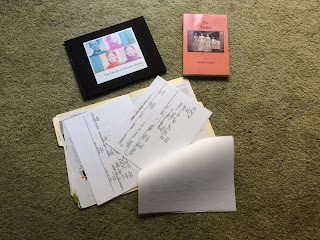The stories you think you’ve passed on to your
children are not necessarily stories they know.
Earlier this year, I was talking with my daughter
about who-knows-what, something to do with languages, and I said that since my
grandmere and grandpere always spoke to each other in French, and usually spoke
in French to my father as well, I had grown up thinking it perfectly ordinary
that grown-ups sometimes spoke to each other in a language the kids didn’t
understand.
“What!” She nearly fell off the sofa. “They spoke
French? I didn’t know that!” She had assumed that they spoke Italian, which
would be a reasonable thing to assume if I hadn’t told her otherwise. My
grandparents had come over from Italy, after all. Just… a French-speaking part
of Italy. At least for Grandmere.
“I’m sure I told you!” And I probably had. Once.
When she was very young. And apparently never again.
So she hadn’t known, and hadn’t had the slightest
idea that her own Granny and Grampy could also speak French (though they didn’t
normally speak it to each other, and probably hadn’t spoken it for years.) Had she known, she said, she might—might—have considered taking French in
school instead of Latin.
Suddenly things were clearer. I had wondered a little
about her choosing Latin. I had offered good reasons why French or Spanish might be more fun (including that fact that I knew some of both and we would be
able to talk together), and in the back of my mind I had wondered that the
family connection didn’t seem to enter into her decision. But I’d never
actually said, “Why don’t you take French? Your great-grandparents spoke French
and your grandparents would probably be delighted.” No, I just assumed she’d
considered that fact and decided that Latin would be more fun, especially since
she already knew the Latin teacher and liked her.
And she did get a series of very fun Latin teachers.
Later she went on the Latin Club trip to Italy, so the family connection did come in, sort of.
But how had I failed to pass on such an important
bit of information? What else had I failed to tell her?
“You know Grandpere was a baker?” Yes, she did
know that. Good.
“And Grandmere worked as a maid?” Yes, and now
that my daughter knew Grandmere had spoken French, the story that Grandmere had
passed herself off as a French maid, not Italian, made more sense. (Apparently
French maids were desirable back then—Italian maids, not so much. Prejudice has
a long history, though the groups involved change.)
But she had a question for me. “What did my other
great-grandpa do?”
Uh.
Photography, though I don’t know whether he made
any money at it. Some acting, apparently. And my mom always says that there was
a brief spell when he sold used cars. And…uh…
I need to go back to my mom and ask more
questions, I think. I wonder what stories she told me that I have now
forgotten?
At any rate, this discovery led to a discussion of
the family tree, a search for the two books I have relevant to that side of the
family (though one is mostly a photo book), and the conclusion that we really
ought to get a genealogy program and sort this all out. And, as my daughter
said, we should write down all the stories I can remember, and all that Granny can
tell us, so that my daughter can pass them on to her own children some day.
Maybe they’ll
decide to take French in school.
Till next post.







